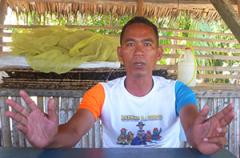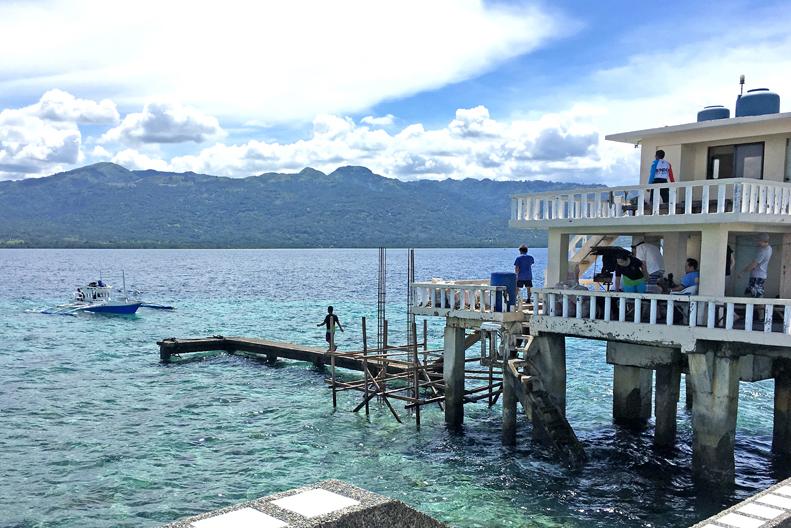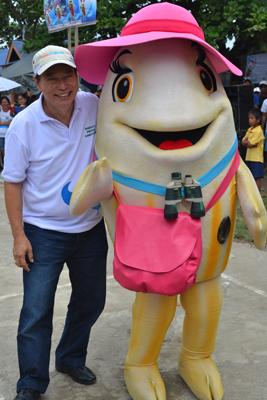More than 20 years ago, 51-year-old fisher Edgar Torres of Bindoy, Philippines, watched his uncle follow a recipe, combining and heating up a handful of ingredients in a frying pan. Key to the recipe was the addition of ammonium nitrate, a chemical used to fertilize mango trees in the Philippines. After that came the detonator.

Edgar Torres’ uncle was an illegal fisher, and the mixture in the pan produced a powerful dynamite fishing device in the form of a homemade bomb. “I watched how they cooked the mixture of chemicals and put the blasting caps,” says Torres. “When I learned how to make it, I was not scared of dynamite fishing because we caught a lot of fish. Sacks of fish. It was a pity — we would leave behind plenty of fish because we could not carry them anymore.” When Torres married and began to have children, he quit the practice. Many others in Bindoy, however, would use dynamite regularly.
For decades, dynamite fishing in Bindoy was widespread and intergenerational, even routine. Fishers like Torres liked the big, quick catch and profits it produced. “It was easy to get fish with this method,” says 53-year-old Rexon Romano. “You don’t have to fish for a long time. If you use dynamite, you just throw it when you see a school of fish, and you get a good catch at once.”
Dynamite fishing is efficient: a bomb is tossed into the ocean, its blasting cap is triggered, and fish are killed or stunned in droves. Bindoy’s illegal fishers often target the vast Mantalip Reef for the fish populations that swim through, and therein lies the price that’s paid to fish with dynamite. It results in severe collateral damage to coral reefs and other marine ecosystems. Blasts leave behind eerie and desolate coral graveyards, sucked of the vibrant color, movement and life for which reefs are known.

Though the practice is illegal, it’s still in use throughout Southeast Asia. A 2006 study of dynamite fishing by researchers at the University of California, Berkeley, detailed its impact: “The detonation of homemade bombs not only kills fish but also shatters the coral skeletons, creating expanses of unstable coral rubble. Furthermore, the removal of the targeted herbivorous fish is likely to reduce the resilience of the reefs to climate change and other impacts, further hampering recovery.”
When single blasts become repeated offenses in the same reef, recovery becomes much harder to accomplish. Dynamite fishing was bad enough for the reef, but it was only one weapon in an arsenal of destructive techniques that illegal fishers used in the area, including poison, trawl nets, and muroami — the use of ropes and rocks to pound coral, drive out fish, and herd them into a waiting net. Left unchecked, illegal and destructive fishing could gradually but irrevocably damage Bindoy’s ocean ecosystems and drain them of their productivity.
By 1998, Mayor Valente Yap knew he had to do something. The reef had been pummeled by illegal fishing for years, and he was concerned about the impact on local food and job security. “Our food is very dependent on the catch of the fishermen,” he says. “Almost 60 percent of our people are dependent on fish. If we don’t take care of our marine resources, of course there will be a decline in fish catch. With the increase in population and decline in fish catch, you cannot meet demand and supply, so we decided to focus more on environmental protection.”
At the root of the destructive fishing norm was a huge disconnect between people and nature — between fishers and their reefs, mangroves and seabeds. Mayor Yap was determined to close the gap. For the next two decades, he would drive fisheries management innovation, marine protection, and pride for nature in Bindoy.
• • •
In 1998, Mayor Yap began cracking down on illegal fishing, particularly around the Mantalip Reef. Mayor Yap worked to convince local fishers to accept the declaration of a marine protected area (MPA), a sanctuary established around the vast coral formation. Fishers initially protested the idea for fear of the near-term impact of closing off access to the teeming reef. But “slowly, they started supporting us,” says Mayor Yap.
Mayor Yap bolstered enforcement in 2004, ordering Bantay Dagat, the local fishery enforcement team (which translates to “Guardians of the Sea”), to target illegal fishers using methods like dynamite and muroami. Led by 59-year-old sea ranger Nazarito Ledama — once a muroami fisher himself — the eight-man team would take turns patrolling the reef. The Bantay Dagat team would apprehend and bring illegal fishers to court, where they faced fines of 2,500 Philippine pesos.
Mayor Yap’s work didn’t end with Bantay Dagat. While it was important for illegal fishers to face consequences for their actions, the long-term health of the reef would depend on a shift in the deeply-ingrained attitudes that enabled sustainable fishing. Dynamite fishing had roots in Bindoy’s history, with origins dating back to World War II. When Japanese forces occupied Negros Island, they used Bindoy as a base. When they were defeated, they left behind a stash of explosives that local fishers repurposed for fishing — a method that would catch fire over the next 50 years.
Rare’s social marketing was able to help us change the thinking of our fishers and people from coastal barangays, and [show them] that what we are doing is for their welfare.”Mayor Valente Yap Mayor of Bindoy, Philippines
Illegal fishing eventually became a family affair. Fathers, sons, brothers and uncles took part together. “The adults would give us allowance for school as our share in the fishing operations,” remembers Nazarito Ledama. Neighborhood kids were recruited by muroami fishers for their swimming skills, he says.

Mayor Yap and the municipal government set out to change attitudes toward illegal fishing, not by shaming illegal behavior, but by bringing about a community-wide conservation ethic. In 2012, Bindoy partnered with Rare to carry out a Rare Pride campaign for sustainable fishing, aiming to inspire the community to pivot their focus from short-term gains to the long-term benefits of sustainable behaviors like the enforcement of marine protections.
Municipal government staffer Richard Balauro led Bindoy’s Pride campaign. “We have what you call a three-in-one ecosystem of mangrove, seagrass and coral reefs,” explains Balauro. “These are interconnected and every ecosystem performs certain functions that are critically important to all marine organisms. The biodiversity of Bindoy and its three ecosystems were destroyed in the past because of illegal practices. The people who did this had no idea what would happen in the future.”
The campaign aimed to help people from Bindoy rediscover their connection to nature and show them how a healthy fishery could change their lives. Richard and his team hosted participatory events and workshops with people’s organizations, plastered conservation messages across billboards, and brought the subject matter into day-to-day conversation. The campaign also made itself present on local holidays and events like Fisherfolks’ Day and Libod Sayaw Festival, where locals were able to meet Bindoy’s Pride mascot, Lovie, a black-spotted snapper, a symbol of recovery in Bindoy after bouncing back from near-collapse thanks to ongoing conservation efforts like MPA enforcement.
Mayor Yap says the community engagement that Pride offered was essential for Bindoy’s transformation. “We cannot implement enforcement and all these programs for the environment without the support of people’s organizations,” he says. “Rare’s social marketing was able to help us change the thinking of our fishers and people from coastal barangays, and [show them] that what we are doing is for their welfare.”
The campaign helped fishers like Edgar Torres understand how their relationship with the marine environment needed to change. “When there was a move to declare Mantalip as a protected area, all 46 hectares of it, I was opposed to the proposal,” he says. “I was thinking, as a fisher, where would we fish? I raised this issue with the mayor. The Pride campaign convinced me to change my mind. I focused on the future of my family. That became my goal, to fish responsibly so my children would have a better tomorrow.”
Torres joined Bantay Dagat that year, and currently serves as chairman of the Tinaogan Fisherfolks Association in Bindoy’s coastal village of Tinaogan. “I was one of those who got educated by Richard [Balauro], and I shared what I learned with the members — what will happen in the future if we do not protect our fishing grounds,” he says. Over time, even the most stubborn of fishers came around. “We used to think that some people would never change, because that’s their nature. But as chairman of our association, I have seen many fishers who really changed their attitudes toward fishing. There are some who still deviate, but most have been bitten by the conservation bug.”
• • •
In 2014, Rare and Bindoy renewed their partnership to enhance the restorative power of Bindoy’s MPAs through “managed access,” a rights-based management approach that grants fishing access in or along MPAs exclusively to local, registered fishers. Integrating fishing rights into the use of MPAs can affect how fishers engage with MPA and management rules: the potential for recovered fish populations and spillover from well-enforced, nearby MPAs acts as incentive for environmental stewardship among local fishers.
Mayor Yap finds the approach intuitive in its community-centered design. “The simplest way for people to protect their marine reserves is to make them understand that they have the priority,” he says. “They have a preferential right, so if they have a sense of ownership over these resources, they will protect it because it’s for their future. It’s for their children.” After soliciting local feedback and participation, Bindoy’s municipal government passed an ordinance that designated about half of the community’s municipal waters, closest to shore, for exclusive use by Bindoy fishers.
The Pride campaign convinced me to change my mind. I focused on the future of my family. That became my goal, to fish responsibly so my children would have a better tomorrow.”Edgar Torres, Former dynamite fisher in Bindoy, Philippines
Today, the fishers of Bindoy are seeing results in rising fisheries productivity and ecosystem recovery. “In the past, I used get just two to four kilos,” says former dynamite fisher Rexon Romano. “Now, we can get 20 kilos, at least. There has been a huge change after we stopped doing illegal fishing. Whenever I dive, I can see the seagrass growing taller, unlike before, when they were almost destroyed.”
Nazarito Ledama has also seen change in the community’s collective attitude toward illegal fishing. Bantay Dagat hasn’t had to arrest anyone since 2013, though they remain active in patrols, and receive help from fishers who call into the team’s hotline whenever they see other fishers breaking the law. Today, it’s difficult to be an illegal fisher in Bindoy, a town that has taken ownership of its marine ecosystems. “In the past, it was only the local government that was enforcing protection of our marine reserve,” says Mayor Yap. “Now, it’s the people who are protecting our marine resources.”
Rare Philippines Senior Manager of Communications Yasmin Arquiza conducted interviews and contributed reporting for this story.